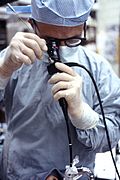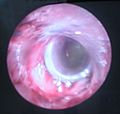Bronchoscopy facts for kids
Bronchoscopy is a special medical procedure that lets doctors look inside your airways. Think of it like a tiny camera that goes into your breathing tubes! It helps them see your trachea (windpipe), and the larger and smaller air tubes inside your lungs called bronchi and bronchioles.
There are three main ways doctors can do a bronchoscopy:
- Using a stiff, straight tube (rigid bronchoscopy)
- Using a thin, bendy tube with a camera (flexible fiberoptic bronchoscopy)
- Using special computer scans to create a 3D picture (CT virtual bronchoscopy)
Contents
What is Rigid Bronchoscopy?
Rigid bronchoscopy uses a straight, stiff tube. This tube is usually inserted while a person is fully asleep under general anesthesia in an operating room.
Doctors often use this method if there's something blocking the main windpipe or the large breathing tubes in the lungs. The tube is wide enough for doctors to pass small tools through it. These tools can help remove things that are causing a blockage.
What is Flexible Bronchoscopy?
Flexible fiberoptic bronchoscopy uses a long, thin, and bendy tube called a bronchoscope. This tube has a light and a tiny camera on the end. It can be gently passed through your nose or mouth and into your airways.
The camera sends live pictures to a screen. This allows the doctor to see clearly inside your windpipe and lung tubes. It helps them check for problems or take small samples if needed.
What is CT Virtual Bronchoscopy?
CT virtual bronchoscopy is a different kind of method. It doesn't use a tube that goes into your body. Instead, it uses information from many CT scans.
These scans are like special X-rays that take many pictures from different angles. A computer then uses all this information to create a detailed three-dimensional (3D) image of your airways. This allows doctors to see inside your breathing tubes without needing to do a physical procedure.
Images for kids
See also
 In Spanish: Broncoscopia para niños
In Spanish: Broncoscopia para niños





